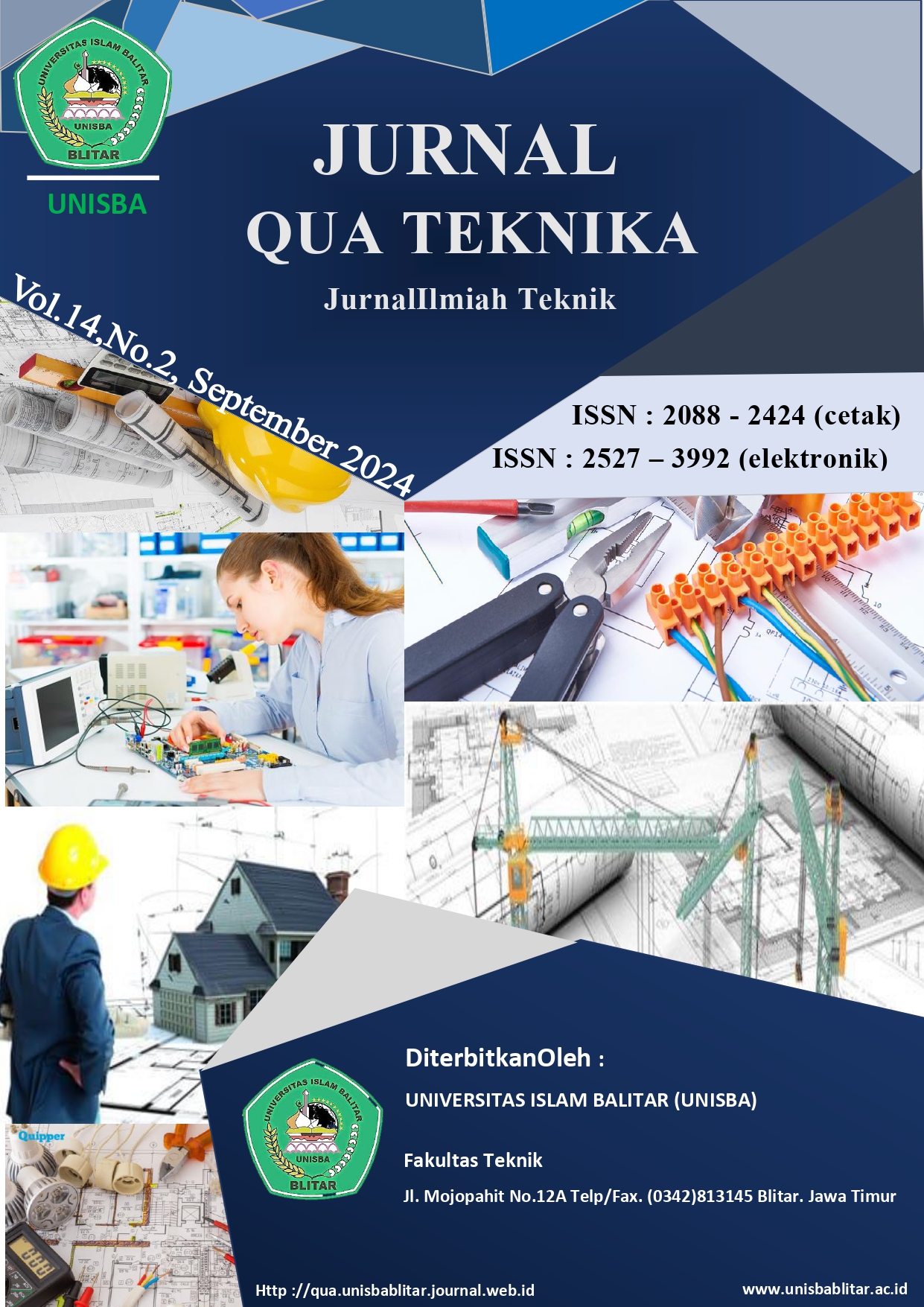PENGGUNAAN FLY ASH DAN BOTTOM ASH SEBAGAI CAMPURAN PEMBUATAN BATA RINGAN DENGAN MENGGUNAKAN PROSES CELLULAR LIGHTWEIGHT CONCRETE (CLC)
DOI:
https://doi.org/10.35457/quateknika.v14i02.3256Keywords:
CLC, Lightweight, SNI 8640:2018, Fly ash, Bottom AshAbstract
FABA (Fly Ash and Bottom Ash) is a residual waste from burning coal which is widely used by industry to produce heat energy, an example is the use of FABA in PLTU (Steam Power Plant). One of the oldest PLTUs in Indonesia, namely PLTU PJB UP Paiton, has been using coal for a long time, the utilization of FABA is still quite minimal due to problems from the government in using FABA due to its entry into Hazardous and Toxic Material (B3) waste, but in 2021 through Regulation Government Number 22 of 2021 concerning the implementation of environmental protection and management is established if FABA is no longer included in B3 waste.
The process of making lightweight bricks is divided into 2, namely AAC (Autoclaved Aerated Concrete) and CLC (Cellular Lightweight Concrete). because the process is relatively simple and does not require expensive special tools. In this study CLC was chosen because it seeks to improve the quality of small industrial materials, so that the products produced meet the standards set by the government.
One way to use FABA waste is to make CLC lightweight brick mixture, because FABA material is classified as having a lighter specific gravity compared to the main material for making CLC fine aggregate at this time, namely sand. In this research, the effect of mixing FABA materials will be examined by substituting sand and cement, to obtain a mixture that is in accordance with SNI 8640: 2018 concerning Specifications for Lightweight Bricks for Wall Pairs.
The results of the research show that the substitution of cement with fly ash produces a smaller dry specific gravity and an increase in strength in mixtures B and C, then the substitution of fine sand aggregate with bottom ash results in a reduction in the CLC specific gravity value, and the compressive strength increases in mixture E, F, G, and H. The CLC lightweight brick mixture that meets the individual and average compressive strength according to SNI 8640:2018 is mixture G.
References
[2] A. Sutrisno and S. Widodo, “Embuatan Bata Ringan Menggunakan Limbah Penggergajian Batu Andesit,” Pros. Semin. Nas. 2013 Menuju Masy. Madani dan Lestari campuran, pp. 405–412, 2013.
[3] B. Goritman, R. Irwangsa, and J. H. Kusuma, “Studi Kasus Perbandingan Berbagai Bata Ringan dari Segi Material, Biaya, dan Produktivitas,” Pratama Tek. Sipil, no. Clc, pp. 1–8, 2012, [Online]. Available: http://studentjournal.petra.ac.id/index.php/teknik-sipil/article/view/389.
[4] X. Liu, C. Ni, K. Meng, L. Zhang, D. Liu, and L. Sun, “Strengthening mechanism of lightweight cellular concrete filled with fly ash,” Constr. Build. Mater., vol. 251, p. 118954, 2020, doi: 10.1016/j.conbuildmat.2020.118954.
[5] S. Anandaraj et al., “Experimental investigation on sugarcane bagasse fiber reinforced concrete using bottom ash as sand replacement,” Mater. Today Proc., no. xxxx, 2023, doi: 10.1016/j.matpr.2023.03.469.
[6] N. Nakararoj et al., “Effects of High-Volume bottom ash on Strength, Shrinkage, and creep of High-Strength recycled concrete aggregate,” Constr. Build. Mater., vol. 356, p. 129233, Nov. 2022, doi: 10.1016/J.CONBUILDMAT.2022.129233.
[7] A. V. Sulistio, S. Wahjudi, and D. Hardjito, “Pada Mortar Hvfa,” pp. 1–8, 2015.
[8] “SNI 8640-2018 03054DSP.pdf.” .
[9] B. A. R. R. and Sugiharti, “Pengaruh Subtitusi Pasir Ngantang Dengan Pasir Silika Tuban Terhadap Kuat Tekan Bata Ringan Dengan Menggunakan Proses Cellular Lightweight Concrete (Clc),” J. Qua Tek., vol. 12, no. 01, pp. 98–105, 2022, doi: 10.35457/quateknika.v12i01.2040.
[10] K. Ramamurthy, E. K. Kunhanandan Nambiar, and G. Indu Siva Ranjani, “A classification of studies on properties of foam concrete,” Cem. Concr. Compos., vol. 31, no. 6, pp. 388–396, 2009, doi: 10.1016/j.cemconcomp.2009.04.006.
Downloads
Published
Issue
Section
License
Authors who publish with this journal agree to the following terms:
- Copyright on any article is retained by the author(s).
- Author grant the journal, right of first publication with the work simultaneously licensed under a Creative Commons Attribution License that allows others to share the work with an acknowledgement of the work’s authorship and initial publication in this journal.
- Authors are able to enter into separate, additional contractual arrangements for the non-exclusive distribution of the journal’s published version of the work (e.g., post it to an institutional repository or publish it in a book), with an acknowledgement of its initial publication in this journal.
- Authors are permitted and encouraged to post their work online (e.g., in institutional repositories or on their website) prior to and during the submission process, as it can lead to productive exchanges, as well as earlier and greater citation of published work.
- The article and any associated published material is distributed under the Creative Commons Attribution-ShareAlike 4.0 International License
Deprecated: json_decode(): Passing null to parameter #1 ($json) of type string is deprecated in /home/ejournal.unisbablitar.ac.id/public_html/plugins/generic/citations/CitationsPlugin.php on line 68










